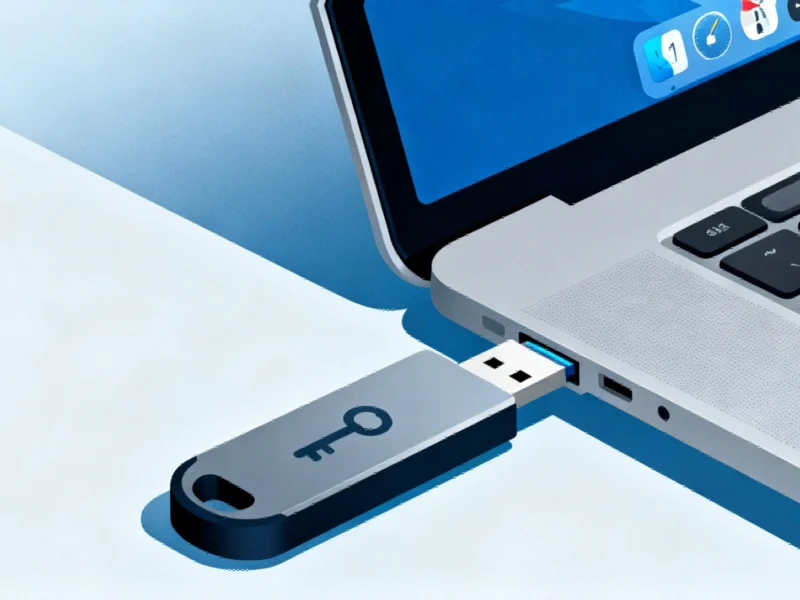As digital security evolves beyond traditional passwords, physical authentication keys are becoming essential for comprehensive protection. While dedicated hardware keys like YubiKey offer robust security, budget-conscious users can now transform ordinary USB flash drives into sophisticated security devices using specialized software. This approach bridges the gap between convenience and security, providing an additional layer that prevents unauthorized access even when someone knows your system PIN.
The concept of converting standard USB drives into computer lock mechanisms represents a significant advancement in accessible security solutions. Unlike traditional password protection that relies solely on memorized credentials, physical key-based security ensures that only someone with both knowledge (PIN/password) and physical possession (the USB key) can access your system.
How USB-Based Security Keys Enhance Computer Protection
USB Raptor stands out as a powerful Windows utility that redefines how we approach computer security. The software operates by creating a unique, encrypted k3y file on your USB drive that contains cryptographic identifiers specific to both your computer and the flash drive. Running quietly in the background, the utility continuously monitors whether the authenticated USB remains connected, automatically triggering a lock sequence when the key is removed.
The security mechanism proves particularly valuable in shared environments where physical access represents the primary vulnerability. Whether you’re working in an open office, using a public computer lab, or simply stepping away from your home workstation, removing the USB key ensures immediate system protection. The locked state presents a security screen that cannot be bypassed without either reinserting the correct USB or entering a backup password.
Setting Up Your USB Security Key: Step-by-Step Configuration
Converting a standard USB drive into a security key requires minimal technical expertise. Begin by selecting any USB flash drive and backing up existing data, as the setup process will reformat the device. After downloading and extracting USB Raptor, launch the application and establish an encryption password—this crucial step enables future key regeneration if needed.
The software automatically detects inserted USB drives and generates the encrypted authentication file with a single click. Advanced configuration options allow users to customize lock behaviors, from standard Windows lock screens to enhanced security interfaces that provide additional protection against bypass attempts. The flexibility extends to adjustable lock delays and optional unlock sounds, creating a personalized security experience.
Emergency Access and Backup Strategies
Understanding that hardware can fail or become lost, USB Raptor incorporates intelligent backup features. The Advanced Configuration section includes a Backdoor Access option that generates a Recovery Unique Identifier (RUID) file. This cryptographic emergency access file should be stored securely—preferably on cloud storage or another protected location—to ensure system accessibility if the primary USB key becomes unavailable.
The backup system addresses one of the primary concerns with physical security keys: the risk of being permanently locked out of your own system. By maintaining both the encryption password and RUID file in separate secure locations, users can balance security with practical accessibility needs.
Understanding the Limitations and Complementary Security Measures
While USB Raptor provides substantial security enhancement, it’s important to recognize its limitations compared to dedicated hardware security keys. Unlike YubiKey devices that utilize specialized cryptographic chips, USB Raptor relies on software running within the Windows environment. This means technically sophisticated attackers with physical access could potentially bypass the protection.
The software cannot prevent access through alternative boot methods or physical hard drive removal. For comprehensive protection, consider combining USB Raptor with full-disk encryption solutions like BitLocker, especially as Microsoft continues enhancing security integration across its ecosystem. This layered approach ensures protection against both casual snooping and more determined intrusion attempts.
Integration with Modern Computing Ecosystems
The concept of enhanced security through physical authentication aligns with broader industry trends toward multi-factor protection. As computing hardware evolves, with innovations like the AMD-powered ROG NUC breaking Intel’s legacy in compact computing, security solutions must adapt to new form factors and use cases.
The gaming and professional computing sectors particularly benefit from these security enhancements, especially with devices like the ASUS ROG NUC mini gaming PC leveraging AMD Ryzen processors for both performance and security capabilities. These systems often contain sensitive game progress, personal data, and sometimes professional work requiring reliable protection.
Practical Applications Beyond Personal Computing
The utility of USB-based security extends beyond traditional computer usage scenarios. In industrial and commercial environments where multiple users access shared workstations, USB Raptor provides an inexpensive method to ensure individual accountability and access control. The approach mirrors how modern industries are implementing AI and automation to enhance security and efficiency across various operations.
For small businesses and educational institutions with limited security budgets, repurposing existing USB drives as authentication keys represents significant cost savings compared to purchasing dedicated security hardware. The solution scales easily across multiple computers and users while maintaining individual access control.
Optimizing Your Security Configuration
To maximize protection, configure USB Raptor to start automatically with Windows and run minimized in the system tray. Password-protect the application interface itself to prevent unauthorized configuration changes. Establish appropriate lock delays that balance security needs with convenience—typically 5-10 seconds provides adequate reaction time while preventing immediate access upon key removal.
Regular maintenance includes periodically verifying that your backup RUID file remains accessible and testing the emergency unlock procedure. Consider designating specific USB drives exclusively for security purposes rather than multipurpose use, reducing wear and potential failure points.
Conclusion: Affordable Security Enhancement for Modern Computing
USB Raptor delivers substantial security improvement at zero cost, transforming everyday USB flash drives into effective physical authentication tokens. While not replacing dedicated hardware security keys for high-risk scenarios, the software provides robust protection against casual access attempts and unauthorized usage in shared environments.
The solution exemplifies how innovative software can democratize security features previously available only through expensive hardware. By leveraging existing USB technology that most users already possess, USB Raptor makes enhanced computer security accessible to everyone from students to professionals, regardless of budget constraints.
Based on reporting by {‘uri’: ‘makeuseof.com’, ‘dataType’: ‘news’, ‘title’: ‘MakeUseOf’, ‘description’: ‘MakeUseOf is your guide in modern tech. Learn how to make use of tech and gadgets around you and discover cool stuff on the Internet.’, ‘location’: {‘type’: ‘country’, ‘geoNamesId’: ‘6252001’, ‘label’: {‘eng’: ‘United States’}, ‘population’: 310232863, ‘lat’: 39.76, ‘long’: -98.5, ‘area’: 9629091, ‘continent’: ‘Noth America’}, ‘locationValidated’: False, ‘ranking’: {‘importanceRank’: 176430, ‘alexaGlobalRank’: 1969, ‘alexaCountryRank’: 1617}}. This article aggregates information from publicly available sources. All trademarks and copyrights belong to their respective owners.



